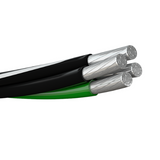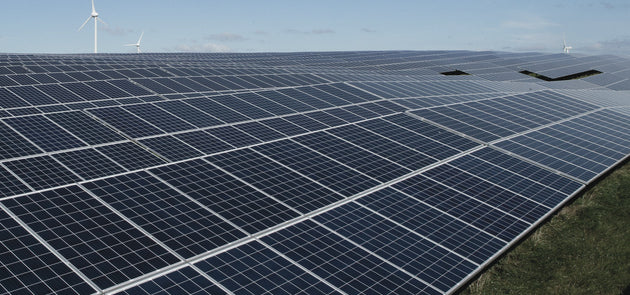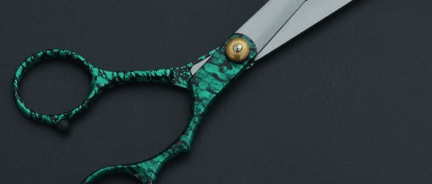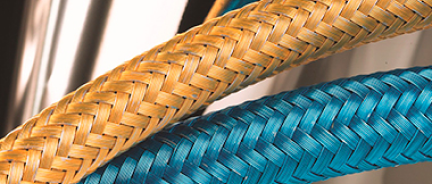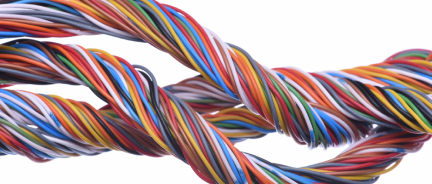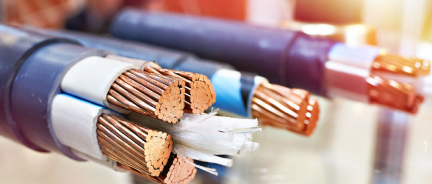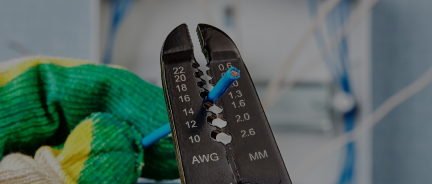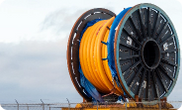Aluminum Mobile Home Feeder Cable vs. Aluminum URD Triplex Quadruplex Cable: A Comparison

Aluminum Mobile Home Feeder (MHF) cable and Underground Residential Distribution (URD) cable are both commonly used aluminum cables, but they are built for different applications and carry different ratings. In some cases, they can be used interchangeably, but only when the proper ratings are present. Here’s a clear comparison to help you choose the right option for your next project.
What Is An Aluminum Mobile Home Feeder Cable?
Aluminum Mobile Home Feeder Wire, or MHF cable, is an aluminum cable with XLPE insulation that is used for permanent wiring in mobile homes where it is mostly used as a service entrance cable. Rated as RHH/ RHW-2/ USE-2, the cable is used for home feeders, electrical panels, and direct burial as long as it falls within the scope of its RHH/ RHW-2/ USE-2 rating.
What Is An URD Cable?
Underground residential distribution wire (URD) is an aluminum wire for underground utility systems where it is installed in ducts or conduits for secondary power distribution. The cable consists of several stranded or compressed strands of aluminum wiring (typically THHN or XHHW). It may be approved for other common applications if it carries an additional rating. Depending on the number of conductors, the cable can be duplex, triplex, or quadruplex. The cable typically also has XLPE insulation.
URD cables by themselves are not NEC-approved for direct burial or indoor use unless they carry additional ratings. Without ratings such as USE-2 or RHH/RHW-2, they are restricted to utility installations outdoors.
Common Facts About Aluminum Home Feeder Cable
- MHF cable is recognized for NEC applications under Article 338.10(B)(4)(a) and Article 550.10(A), and is suitable for direct burial.
- Aluminum Home Feeder cable always has a triple rating of RHH or RHW-2 and USE-2. Because of this, it is allowed to go inside the building.
- The initial goal of the aluminum home feeder cable is to connect the mobile home's outdoor with the interior panel located in the building.
Common Facts and Confusions About URD Cable
- URD aluminum cable translates as underground residential distribution cable.
- A URD cable that carries nothing but a URD rating is not permitted for applications indoors. If the cable does not have additional ratings, it is only approved for utility work. In itself, URD cable is not the title recognized by the National Electrical Code for NEC applications.
- However, when URD is rated USE-2 or RHH/RHW-2, it complies with NEC Articles 310 and 338, depending on construction. The cable can be used for various other applications, including home feeders, electrical panels, and direct burial, if it carries an additional rating required for this.
- The confusion regarding URD cable stands from the fact that some electricians refer to aluminum cables in general as URD. However, if you wish to use these cables for anything other than utility service, you should always check additional ratings.
- A URD Cable can be triple-rated as RHH RHW-2 and USE-2, but it is not guaranteed.
Additional Applications of URD Cable
When URD cable is dual- or triple-rated (e.g., as USE-2 or RHH/RHW-2), it can be used for:
-
Direct burial (if USE-2 rated)
-
Home feeders and subpanels (if RHH/RHW-2 rated)
-
Light commercial underground secondary distribution
-
Cost-effective residential projects where copper is not preferred
URD cables that consist of XHHW or THHN-rated individual conductors should be treated according to the rating of those individual wires.
Even though it is an underground cable, a URD cable is not approved by the National Electrical Code for direct burial applications unless it is double-rated as USE-2. Aluminum USE-2 cable is a common alternative to copper when it comes to direct burial. It is safe, effective, and helps make an electrical project less expensive.
Generally, aluminum URD cable is cheaper than aluminum mobile home feeder cable, but its prices may vary significantly depending on the additional ratings. If the URD cable has the required rating, it can be an excellent cheap solution for an electrical project. Moreover, there is also one electrical cable that is very easy to pull.
Depending on the store or the area, URD and mobile feeder home cables can both be cheaper than single-conductor aluminum XHHW cables.
Overlapping Applications of MHF and URD Cable
When properly rated, both MHF and URD cables can serve in several overlapping applications, including:
-
Direct burial projects (if both are USE-2 rated)
-
Residential feeder cables
-
Service entrances (when URD is rated RHH/RHW-2)
-
Electrical panel connections
-
Light commercial secondary power distribution
These applications are only interchangeable if the URD cable includes the necessary NEC-approved ratings. Otherwise, MHF remains the more universally approved option due to its built-in compliance.

How to Choose Between MHF and URD for Overlapping Applications:
-
Choose MHF if you need a guaranteed NEC-compliant cable that can be buried, run indoors, and used in panels without checking extra specifications. It's a plug-and-play solution for most residential projects.
-
Choose URD if you're looking to reduce costs and you can confirm the cable is dual- or triple-rated (e.g., USE-2 and/or RHH/RHW-2). Always verify the printed ratings on the jacket or check the manufacturer’s datasheet before making your choice—this ensures compliance and avoids costly installation mistakes.
URD is not a lesser cable. It simply has more variability depending on how it's manufactured and rated. When properly labeled and installed according to its ratings, URD is a reliable and cost-efficient solution for many of the same tasks MHF performs. It’s especially useful for outdoor and underground utility distribution and can become just as versatile when the right specifications are met.
If you're unsure which cable to select, it's safer to go with MHF, especially for indoor or direct burial applications, unless URD's rating is explicitly confirmed.
When to Use MHF vs. URD: A Quick Scenario
Use MHF Cable if:
You’re wiring a mobile or modular home, and need a cable to run from the outdoor disconnect to the indoor panel. You want a code-compliant solution for direct burial, indoor routing, and subpanel connections—with no need to check extra ratings. MHF includes both a neutral and a ground wire, making it ideal for most residential installations.
Use URD Cable if:
You’re powering a detached garage, pole barn, or small outbuilding using a long underground conduit, and you plan to run a separate ground wire. You’ve verified that the URD cable is USE-2 rated, making it safe for direct burial. In this setup, URD is a cost-effective, lightweight, and easy-to-install option, especially in triplex or quadruplex configurations.
URD vs. MHF: A Summary
In terms of the structure, the difference between URD and MHF cables is that a standard URD only has a neutral wire, whereas MHF has both a neutral and a ground wire.
The bottom line is that both mobile feeder and URD can be used for many common aluminum cable applications. Still, you are likely to have better luck with mobile feeder because it automatically carries RHH/ RHW-2/ USE-2 and direct burial ratings, which is only optional for URD, which is only a utility wire when it does not have extra ratings.
Because of its versatility, aluminum Mobile Home Feeder Cable is considered a cheap alternative for many common electrical applications. For high-quality URD and MHF cables for prices no one can beat, visit Nassau National cable. For years, these two cables have been the most popular products in our store, with thousands of satisfied customers. Our URD cables are rated for direct burial.



